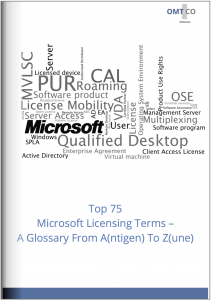Posted April 2013 | by Johannes Balzer

ContentExecutive Summary |
Executive Summary
Executive Summary
This glossary is aimed at those in Software licensing and Software Asset Management facing the challenges of Microsoft licensing.
This glossary explains buzzwords and abbreviations used by Microsoft licensing professionals. It will help you to understand the meanings behind current, and former, licensing vocabulary.
The glossary presents 75 Microsoft licensing terms:
- Terms related to Microsoft product licensing. Microsoft differentiates License and Software Assurance, metrics, product components, suites and restrictions. Full Package Product Licenses (FPP) may be purchased from retailers. Microsoft Volume Licensing customers should verify licensing terms in Microsoft’s Product Use Rights (PUR). Client Access Licenses (CAL) allow clients to connect to server software. CAL suites, such as the Core CAL Suite and Enterprise CAL (ECAL) Suite, govern access to various servers. Terminal Servers (now RDS Remote Desktop Services), VDA (Virtual Desktop Access) and VDI (Virtual Desktop Infrastructure) increase the complexity of licensing.
- Terms related to license administration and Software Asset Management (SAM). Microsoft’s licensing terms define mandatory administrative activities. Licenses must be assigned to a device or user. Licenses may be re-assigned; customers not benefiting from License Mobility must comply with the 90 Day Rule. Microsoft provides license administration features in Microsoft Volume Licensing Service Center (MVLSC). MAP toolkit, a free scan tool from Microsoft, may help to gather information on deployments and infrastructure.
- Terms related to the purchase of Microsoft products. Customers can purchase Microsoft licenses from a Large Account Reseller (LAR), a channel partner, or from Microsoft directly via an Enterprise Agreement (EA). Resellers can purchase Microsoft licenses from Microsoft-authorized distributors. Computer manufacturers can license their desktops’ OS by Original Equipment Manufacturer (OEM) or System Builder (SB). Hosting Services have to be licensed with the Service Provider License Agreement (SPLA).
Should you have any questions, please contact OMTCO; contact details are listed at the end of this report. For those executives interested in sharing their thoughts on licensing, Software Asset Management or compliance audits, we highly welcome your feedback and comments.
Glossary
Antigen | A product that provides security for Microsoft Exchange-based email systems. Antigen has now become Microsoft Forefront Protection, licensed as an Online Service Subscription.
Authorized Distributor | A distributor authorized by Microsoft to provide genuine Microsoft software.
Authorized Education Reseller (AER) | A reseller authorized by Microsoft to provide Open-E and Select-E licenses to facilities entitled to benefits.
Batching | A term related to databases which comprises the automated processing of jobs, usually at scheduled times. Microsoft SQL Server does not require CALs (Client Access Licenses) for batching.
Certified Partner | A Microsoft Partner status providing proven competences in different areas.
Certificate of Authenticity (CoA) | A Microsoft label to ensure that Microsoft software is genuine. The CoA of Windows (Desktop) products is a component of the license proof.
Client Access License (CAL) | A license to allow clients to connect to its server software (Windows CAL for Windows Server access) or additional services (RDS CAL for Remote Desktop Services).
Client OSE | “OSE running a client operating system.” (Microsoft PUR)
Competitive Upgrade | A previous license option to migrate from a third-party product to a Microsoft product. To be valid, Competitive Upgrade required the license of the third-party vendor as the base license. Usual Competitive Upgrades were from Oracle databases to Microsoft SQL or from IBM Lotus Notes to Microsoft Exchange.
Core CAL | A suite of client access and management licenses including: Windows Server CAL, Sharepoint Server Std CAL, System Center Configuration Manager Client Management License, System Center Endpoint Protection & Lync Server Std CAL.
CSVDE | An admin command to extract data from the Active Directory Lightweight Directory Services (AD LDS) e.g. user account data, device account data etc.
Directory Service (Active Directory) | Active Directory is the Microsoft Directory Service within Windows networks. AD data may be used to measure license demand, e.g. for CALs.
Dynamic Access Control (Active Directory) | A means to manage and protect data access, manage identity infrastructure, and provide secure access to data from anywhere (introduced with Windows Server 2012).
E-Open | An online tool for license administration which had been replaced by MVLSC.
End User License Agreement (EULA) | EULA is a contract between the licensor and purchaser, establishing the purchaser’s right to use the software.
Enrollment | Sign-up form to participating license programs e.g. Enterprise Agreement.
Enterprise Agreement | A license program (perpetual) to standardize desktop licensing with the latest versions of Microsoft licenses.
Enterprise CAL (ECAL) | A license suite including the CORE CAL Suite and in addition: Exchange Server Enterprise CAL, SharePoint Server Enterprise CAL, Lync Server Enterprise CAL, Windows Server Rights Management Services CAL, System Center Client Management Suite. Important note: An Enterprise CAL is not required to access Server Enterprise Edition, but to access a Server Enterprise feature.
External Connector License | A server license to cover server access by external users.
External Users | “Users that are not either your or your affiliates’ employees, or your or your affiliates’ onsite contractors or onsite agents.” (Microsoft PUR)
Forefront | A product family for IT security purposes. Forefront Threat Management Gateway can be licensed by a perpetual license; all other Forefront products are licensed by Online Service Subscriptions. This product is to be discontinued.
Full Package Product License (FPP) | A license included within a boxed product, purchased from retailers.
Image | A software package to load multiple devices with the same configuration. Windows Desktop is usually is provided by an image. Beware of installing your own image licensed only by OEM licenses – this requires a volume license.
ISV Royalty License | A license program for independent software vendors to integrate their solutions into Microsoft technology.
Large Account Reseller (LAR) | A license reseller authorized to provide select licenses.
License Advisor | A broker (usually the Large Account Reseller) between customers and Microsoft to convey Enterprise Agreements or Enterprise Agreement Subscriptions.
License and Software Assurance | Combination of the license and maintenance.
License Assignment | A license needs to be assigned to a device or a user before deploying/accessing the software.
License Inventory Report | A summary, provided by Microsoft, of licenses known to be purchased by the customer.
License Mobility | You may reassign certain server licenses on a short-term basis under License Mobility within Server Farms rights and Server Repartitioning. (Microsoft PUR).
License Server | A feature within Windows Server required for Terminal Services / Remote Desktop Services (RDS). The license server is the console where you have to register your TS / RDS CALs.
Mail | Microsoft Mail was the precursor product of Microsoft Exchange Server 4.0.
Management License | Counterpart to CAL for Management Server.
Management Server | Software for client management – deployment and inventorying.
MAP toolkit | The Microsoft Assessment and Planning Toolkit (MAP) is a tool used to provide hardware and software information.
Microsoft Audit Letter | Announcement of a License Compliance Audit driven by Microsoft Ireland.
Microsoft Desktop Optimization Package (MDOP) | A toolset for application and virtual desktop virtualization purposes.
Microsoft Developer Network (MSDN) | A Microsoft organization for developers. Their subscription licenses are relevant to identify from a license balance point of view.
Multilingual User Interface (MUI) | Provides additional languages for the user interface.
Multiplexing | Hardware or software used to pool connections, reroute information, reduce the number of devices or users that directly access or use the product. This is also used to reduce the number of operating system environments (OSEs), devices or users the product directly manages (sometimes referred to as “multiplexing” or “pooling”). It does not reduce the number of licenses of any type that you need.
Microsoft Volume Licensing Service Center (MVLSC) | A Microsoft online platform to provide information regarding a customer’s license estate and installation keys.
.NET | The Microsoft software framework (rivalling Oracle Java). Its high-level language is C# (vs. J2EE); its language for web applications is ASP.net (vs. JSF, JSP2 etc.); Microsoft Silverlight is the competitor to Adobe Flash.
Non-Perpetual | In Microsoft licensing terms this means that a license provides use rights for a limited period of time only.
Ninety (90) Day Rule | Microsoft grants you the right of reassigning a license 90 days after its last assignment.
Open License | A license program (containing OPEN-NL and OPEN C, OPEN Value and OPEN Value subscriptions) for low license volumes.
Operating System Environment (OSE) | An operating system instance, or a virtual operating system instance, which enables separate machine identity.
Original Equipment Manufacturer (OEM) | A license program for computer manufacturers to provide their hardware with licensed software, especially operating systems.
Perpetual License | In Microsoft licensing, a perpetual license gives use rights without time limitations. A non-perpetual license is limited to a particular period of time.
Peak License Demand | When moving instances within a server farm without license mobility, your peak license demand may top your planned license demand as you need to assign a license before installing/deploying the product on the device.
Physical OSE | “An operating system instance or a virtual operating system instance which enables separate machine identity.” (Microsoft PUR)
Product activation | Some products and online services are protected by technological measures and require activation and a Volume License key to install or access them.
Product Use Rights (PUR) | The Product Use Rights document is published on Microsoft’s homepage and is part of the license between Microsoft and Microsoft Volume Licensing customers.
Qualifying Third Party Device | “A device that is not controlled by the customer or the customers’ affiliates.” (Microsoft PUR)
Redist.txt | This text file provides the information regarding what you are allowed to redistribute with your own programs or code.
Remote Desktop Services (RDS) | Terminal Services (TS) has been expanded and has been renamed to Remote Desktop Services (RDS).
Rental Rights | Licenses that permit organizations to rent, lease, loan, or outsource PCs to third parties.
Reporting Services | A component of Microsoft SQL Server since the 2005 version. Microsoft Reporting Services is essentially Microsoft’s version of a Business Intelligence (BI) product.
Roaming | Roaming use rights allow users with Software Assurance on Office, Project, or Visio to remotely access their software on their virtual desktops from third-party devices.
SAM (Software Asset Management) Engagement Letter | Announcement of a so-called friendly compliance audit.
Select | A license program for large license volumes (perpetual). Select has been modified and renamed to Select Plus.
Select Plus | A license program for large license volumes (perpetual). This is the successor to the Select license program.
Service Provider License Agreement (SPLA) | A license program for service providers and independent software vendors (ISVs) to license the latest Microsoft software, to provide software services and hosted applications to customers.
Software as a Service (SaaS) | On-demand services as application service providing.
Software Assurance (SA) | Software maintenance, updates and further benefits including license mobility, tools and resources.
Solution Provider | A former partner program, replaced by the Certified Partner program.
StepUp License | Allows you to upgrade to a higher edition. For the StepUp license, active Software Assurance is necessary.
Subscription License | A licensing model (non-perpetual) to ensure that the latest version is licensed. The programs are: EA Subscription, OPEN Value, MSDN.
System Builder (SB) | A license program for computer manufacturers to provide their hardware with licensed software, especially operating systems.
TechNet | A resource for technical information, e.g. downloads for evaluation.
Terminal Server | A feature within Windows Server that provides application server services. Dedicated product edition only in Windows Server 4.0 Terminal Server Edition. Terminal Services has been renamed to Remote Desktop Services (RDS).
Trial Version | A product from Microsoft limited to a certain time period for the purpose of evaluation. Trial versions are usually limited to 90, 120 or 180 days.
True Up | A yearly report to Microsoft of claimed licenses within a subscription license or Enterprise Agreement.
Update path | A former licensing model enabling the combination of a base license with an update license. This model has been obsolete since the launch of Software Assurance (SA).
Virtual Desktop Access (VDA) | VDA is the license required to use Virtual Desktop Infrastructure (VDI).
Virtual Desktop Infrastructure (VDI) | Virtual Desktop Infrastructure (VDI) is a service that hosts users’ desktop environments on remote servers.
Virtual Machine | A non-physical machine providing an OSE.
Zune | A consumer media player from Microsoft, rivalling the Apple iPod. Now discontinued.
(Posted April 2013)
– CONFIDENTIALITY NOTICE –
OMTCO does not disclose clients’ names, client projects or data. The case study and data published in this report is generic and derived from years of compliance reviews. All analysis presented and information disclosed in this document are exclusively based on public information. Should you wish to learn more about our confidentiality practice or about this case study, please contact an OMTCO representative.
Top 75 Microsoft Licensing Terms – A Glossary From A(ntigen) To Z(une)
THIS GLOSSARY DISPELS THE MYSTERY THAT SURROUNDS MICROSOFT’S LICENSING TERMS. IT WILL HELP YOU TO UNDERSTAND VENDOR’S VOCABULARY AND AUDITORS’ BUZZWORDS, ULTIMATELY MAKING YOU SOUND LIKE AN EXPERT.
is a consultant
at OMTCO Munich Office.
Contact:
00 49 163 3368736
johannes.balzer@omtco.de
 Andreas Burghardt
Andreas Burghardtis a consultant
at OMTCO Cologne Office.
Contact:
00 49 160 97637697
andreas.burghardt@omtco.de
OMTCO provides its clients with the best, thought-out advisory and line services, ranging from design-stage to implementation in Operations, Management, Technology and Consulting.
OMTCO works with the highest possible level of expertise – taking into account our know-how and our pragmatic experience from market analysis, competitive projects and professional references.
OMTCO has Oracle licensing expertise at its disposal, in addition to extensive experience in Oracle compliance reviews and customer-sided counter-audits.
Should you wish for advice tailored to your specific needs, raise comments or ask questions, please contact OMTCO at info@omtco.de or call your OMTCO representative directly.
For Microsoft licensing expertise, visit:
http://omtco.eu/references/microsoft/
For Software Asset Management, visit:
http://omtco.eu/references/SAM/
For counter-audit experience, visit:
http://omtco.eu/references/counteraudit/
For further references, visit:
http://www.omtco.eu/references/
This document is current as of the initial date of publication and may be changed by OMTCO at any time. Not all offerings are available in every country in which OMTCO operates. THE INFORMATION IN THIS DOCUMENT IS PROVIDED “AS IS” WITHOUT ANY WARRANTY, EXPRESS OR IMPLIED, INCLUDING NO WARRANTIES OF MERCHANTABILITY, FITNESS FOR A PARTICULAR PURPOSE AND ANY WARRANTY OR CONDITION OF NON-INFRINGEMENT. This report is for information and illustration purposes only. It is not an advisory document and does not take into account your specific customer situation. Please refer to the disclaimer published at http://omtco.eu/disclaimer.

